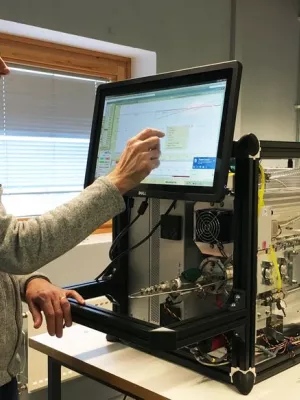
Erik Swietlicki
Professor

Measurement report : Black carbon properties and concentrations in southern Sweden urban and rural air-the importance of long-range transport
Författare
Summary, in English
Soot, or black carbon (BC), aerosol is a major climate forcer with severe health effects. The impacts depend strongly on particle number concentration, size and mixing state. This work reports on two field campaigns at nearby urban and rural sites, 65gkm apart, in southern Sweden during late summer 2018. BC was measured using a single-particle soot photometer (SP2) and Aethalometers (AE33). Differences in BC concentrations between the sites are driven primarily by local traffic emissions. Equivalent and refractory BC mass concentrations at the urban site were on average a factor 2.2 and 2.5, with peaks during rush hour up to a factor g1/44, higher than the rural background levels. The number fraction of particles containing a soot core was significantly higher in the city. BC particles at the urban site were on average smaller by mass and had less coating owing to fresh traffic emissions. The organic components of the fresh traffic plumes were similar in mass spectral signature to hydrocarbon-like organic aerosol (HOA), commonly associated with traffic. Despite the intense local traffic (g1/4g30g000 vehicles passing per day), PM1, including organic aerosol, was dominated by aged continental air masses even at the curbside site. The fraction of thickly coated particles at the urban site was highly correlated with the mass concentrations of all measured chemical species of PM1, consistent with aged, internally mixed aerosol. Trajectory analysis for the whole year showed that air masses arriving at the rural site from eastern Europe contained approximately double the amount of BC compared to air masses from western Europe. Furthermore, the largest regional emissions of BC transported to the rural site, from the Malmö-Copenhagen urban area, are discernible above background levels only when precipitation events are excluded. We show that continental Europe and not the Malmö-Copenhagen region is the major contributor to the background BC mass concentrations in southern Sweden.
Avdelning/ar
- LTH profilområde: Aerosoler
- Institutionen för naturgeografi och ekosystemvetenskap
- Kärnfysik
- MERGE: ModElling the Regional and Global Earth system
- LU profilområde: Ljus och material
- LTH profilområde: Nanovetenskap och halvledarteknologi
- NanoLund: Centre for Nanoscience
- LU profilområde: Naturbaserade framtidslösningar
- Metalund
- Centrum för miljö- och klimatvetenskap (CEC)
- LTH profilområde: Energiomställningen
- Ergonomi och aerosolteknologi
Publiceringsår
2023-03-08
Språk
Engelska
Sidor
3051-3064
Publikation/Tidskrift/Serie
Atmospheric Chemistry and Physics
Volym
23
Issue
5
Dokumenttyp
Artikel i tidskrift
Förlag
Copernicus GmbH
Ämne
- Meteorology and Atmospheric Sciences
Status
Published
Projekt
- Continental Biosphere Aerosol Cloud climate feedback loop during the Anthropocene
- Modelling atmospheric new particle formation from first principles – The role of Highly Oxygenated organic Molecules in clean and polluted air
ISBN/ISSN/Övrigt
- ISSN: 1680-7316